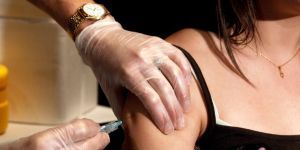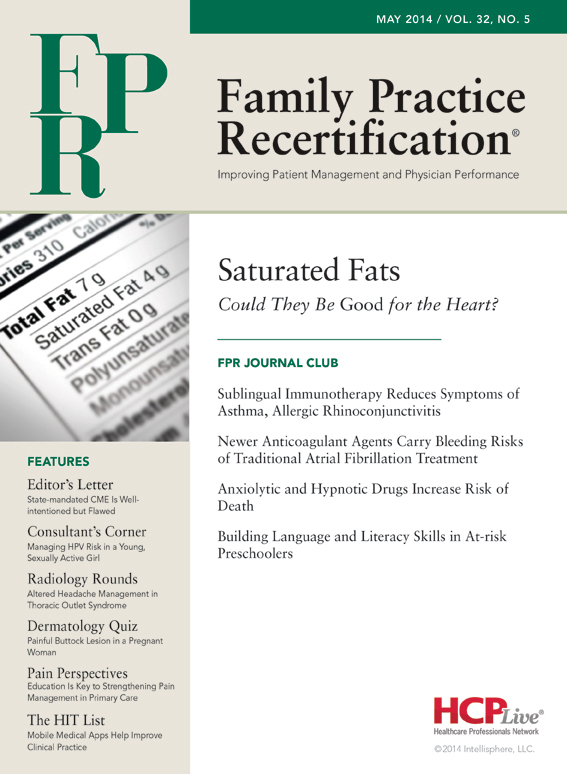Publication
Article
Family Practice Recertification
How Should I Manage HPV Risk in a Young, Sexually Active Girl?
Author(s):
A significant number of sexually active individuals will become infected with HPV at some point in their lifetimes.

You see an 18-year-old high school female for a checkup. Although her past medical history is unremarkable and she is not taking any medications, the patient relates that her mother recently learned she has been sexually active for more than 2 years and told her to get a Pap smear and vaccination against cervical cancer because of it.
Is a Pap smear indicated?
No, a Pap smear is not indicated for this patient. Evidence-based recommendations from the American Society for Colposcopy and Cervical Pathology (ASCCP), the US Preventive Services Task Force (USPSTF), the American Cancer Society (ACS), and the American College of Obstetricians and Gynecologists (ACOG) all agree that a Pap test is not indicated in patients under 21 years old, regardless of their age at first sexual intercourse.
Why is a Pap smear no longer recommended?
The recommendation not to initiate Pap testing in women under the age of 21 was based on the low risk of cervical cancer in this age group (~0.1 cases per 100,000) with concomitantly high rates of transient human papillomavirus (HPV) infection. Women aged 25 years and younger have the greatest risk of HPV infection. Fortunately, 70% of HPV infections with “high risk” or carcinogenic viral subtypes will spontaneously regress.
The potential harms of overdiagnosis include anxiety associated with a positive screening test, the stigma of a sexually transmitted infection diagnosis, pain and bleeding from diagnostic testing, and reproductive harm that may result from surgical treatment of cervical lesions, such as preterm delivery.
Are all cases of cervical cancer caused by HPV?
Yes, extensive evidence supports the role of oncogenic HPV as the etiologic agent of virtually all cervical cancers, and epidemiologic studies have isolated HPV DNA from nearly 100% of tested cervical cancer specimens. HPV is also implicated as the causative agent of other types of cancers in mucosal and skin epithelium in the anogenital region, upper respiratory tract, and digestive tract.
What is the natural history of HPV infection in women?
A significant number of sexually active individuals will become infected with HPV at some point in their lifetimes. Within 4 years of initial intercourse, the cumulative incidence of HPV infection approached 50% in one female college student cohort. Women inoculated with “low-risk” HPV types 6 or 11 may either be asymptomatic or clinically manifest the infection with the appearance of genital warts or low-grade Pap smear abnormalities. Those inoculated with “high-risk” HPV types — primarily 16 and 18 — may also be asymptomatic or clinically manifest the infection with low- or high-grade Pap smear abnormalities.
Although the vast majority (90%) of new HPV infections clear up within 2 years of acquisition, it is unclear whether they resolve by complete viral clearance or maintenance of a viral latent phase. The persistence or recurrence of a high-risk HPV infection is the most important risk factor for progression to cervical intraepithelial neoplasia (CIN) and invasive cervical cancer. The risk for persistence and progression to precancerous or cancerous lesions varies by HPV type, with HPV 16 being the most oncogenic of the high-risk types.
Generally, the time between initial HPV infection and cervical cancer spans decades. Only rarely has an HPV infection progressed from infected yet normal epithelium to cancer in less than 3 years.
At what age is HPV vaccination recommended?
In the last decade, HPV vaccination has become the primary prevention strategy against cervical dysplasia and cancer. Since 2007, the US Centers for Disease Control and Prevention (CDC) Advisory Committee on Immunization Practices (ACIP) has recommended the routine vaccination of girls between the ages of 11 and 12. The vaccine can be administered as early as 9 or 10 years of age, and catch-up vaccination is recommended for females aged 13-26 years old who have not initiated or completed the series.
Can HPV vaccination benefit a patient who has been sexually active and exposed to the virus as a result?
The benefit of the vaccine will vary depending on patients’ pre-vaccination acquisition of HPV infections and the types of HPV they acquired. Ideally, the vaccine is administered before exposure to HPV via sexual contact, as there is no evidence of it offering protection from established HPV infections. However, it is not feasible to determine prior or existing type-specific infection.
Fortunately, infection with one HPV type does not hinder vaccine-induced protection from infection by other vaccine types. Therefore, sexually active females who have not been previously infected with any of the HPV vaccine types will receive full benefit from vaccination, while those who have already been infected with one or more of the vaccine HPV types will be protected only from the vaccine types they have not previously acquired.
Is there an age above which HPV vaccination is not recommended?
HPV vaccines are only licensed for use in females aged 26 years or younger; however, clinical trials on the vaccines suggest safety, tolerability, and immunogenicity in women between the ages of 27-45 years. Although a published trial of Gardasil demonstrated efficacy to prevent cervical intraepithelial neoplasia (CIN) of any grade in that older group, the study was not powered to detect efficacy for the prevention of high-grade CIN, which is a more clinically significant target.
While women without prior exposure to vaccine types could benefit from the vaccine, the reduced cost-effectiveness of immunization in this age group would impede expansion of routine age recommendations. Therefore, initiation of the series in patients aged older than 26 years involves off-label use. However, once initiated, the series can and should be completed even if the patient is older than 26 at completion.
What HPV vaccines are available and how do they differ?
Two non-infectious HPV vaccines are currently available. Cervarix (HPV2) is a bivalent vaccine directed against HPV types 16 and 18, the 2 viral types that cause 70% of cervical cancers, in addition to a significant percentage of vulvar, vaginal, penile, anal, and oropharyngeal cancers. Gardasil (HPV4) is a quadrivalent vaccine that also targets HPV types 16 and 18, as well as types 6 and 11 that are responsible for 90% of external genital warts.
Both vaccines are routinely recommended for girls between 11 and 12 years of age and are delivered via intramuscular injection in 3 doses over 6 months. Each is formulated with a different salt adjuvant that may lead to differences in the level of invoked immune response.
In large, multinational, randomized controlled trials of young women aged 15-26 years, both vaccines had proven safety and efficacy in preventing type-specific HPV infection and high-grade cervical disease. Additionally, they both demonstrated some reduction in risk of high-grade cervical disease caused by non-vaccine HPV types.
Nevertheless, Gardasil is the only vaccine with proven efficacy in the prevention of vulvar intraepithelial neoplasia (VIN), vaginal intraepithelial neoplasia (VAIN), and external genital warts, and it is also the only vaccine licensed for use in males.
How long are HPV vaccines effective?
Due to the limited availability of follow-up data, the vaccines’ duration of protection has not been definitively determined. However, women sustained detectable antibody response with Gardasil for more than 4 years, while those vaccinated with Cervarix maintained antibody titers up to 8.4 years after the initial vaccination at levels higher than those induced by natural infection. These data are encouraging in that they suggest the vaccines will provide protection against incident HPV infection through the peak years of anogenital HPV exposure and acquisition.
The patient completes a series of HPV vaccination and returns to see you at age 21 for a well-woman visit. Why is a Pap smear still recommended despite her HPV vaccination?
HPV vaccination has not led to changes in the universality of cervical cancer screening recommendations for women aged 21 years or older. While the vaccines offer protection against the 2 most oncogenic HPV subtypes, 30% of cervical cancers are caused by an additional 12 high-risk HPV subtypes. Therefore, vaccinated women are still at risk for some cancers from HPV.
Similarly, the longevity of protection conferred by the vaccine is only partly understood. Additionally, the vaccines have no therapeutic effect in HPV-related disease, so they will not treat HPV infections or cervical dysplasia that is potentially prevalent at the time of vaccination.
Is HPV typing an option as an adjunct to this patient’s Pap smear?
The link between high-risk HPV infection and cervical cancer underlies the strategy to incorporate testing for carcinogenic HPV types into cervical cancer screening. HPV high-risk typing alongside Pap testing in women aged 30 years and older is called “co-testing.” Due to the high prevalence of transient HPV infections in women between the ages of 21 and 29, HPV testing is not sufficiently specific for use as a screening test in those aged younger than 30 years, so it is not recommended as a screening adjunct in this age group. Rather, women aged 21—29 years should be screened with a Pap test alone every 3 years.
The patient’s Pap smear reveals atypical squamous cells of undetermined significance (ASCUS). What workup would you recommend?
The preferred management strategy for women aged 21—24 years with ASCUS or low-grade squamous intraepithelial lesion (LSIL) cytology is to follow the patient with early rescreen cytology at 12 and 24 months. However, a reflex HPV test is an acceptable alternative to triage the patient to either a routine or early rescreen interval.
If the reflex high-risk HPV subtyping is negative, then the patient may return to a routine screen with cytology alone in 3 years, but if it is positive, then the patient is recommended to have repeat cytology at 12 and 24 months.
Why is HPV vaccination also recommended in men?
While related cervical cancers were the initial focus of the HPV vaccine, it is also the case that more than 25% of all HPV-related cancers occur in men. HPV-related malignancies in men include anal, penile, and oropharyngeal cancers, all of which are caused primarily by HPV 16.
Given the data supporting Gardasil’s efficacy in preventing anal intraepithelial neoplasia (AIN) in men, the US Food and Drug Administration (FDA) included the prevention of anal cancer in men and women as an indication for the vaccine. In 2011, the ACIP extended their recommendations to include routine HPV vaccination for all boys aged 11-12 years. The vaccine can be administered as early as 9 years of age, and catch-up vaccination is recommended for boys aged 13-21.
The vaccine is licensed — though not “routinely recommended” — for use in men between 22 and 26 years old, and recommendations to vaccinate males through 26 years of age are reserved for certain populations, such as immunocompromised men and men who have sex with men.
About the Author
Jacqueline Cope, MD, is Health Sciences Assistant Professor of Family Medicine in the David Geffen School of Medicine at UCLA. All questions were posed by Family Practice Recertification Editor-in-Chief Martin Quan, MD.






